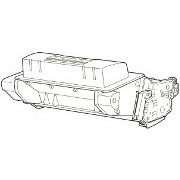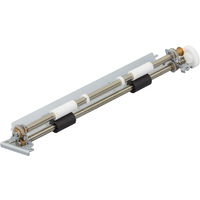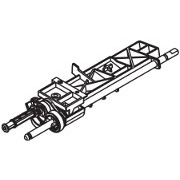HP Original Cartridges for Quality and Reliability
Reliable Remanufactured Cartridges for Low Cost Print
Replacement Paper Drive Pickup
Paper Pickup associated parts
Clutch RM1-5057 does not appear to be available as a separate part
HP RM1-4532 Paper Pickup Drive for P4014, P4015 and P4515 printers.
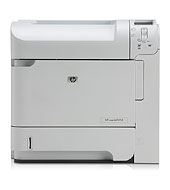
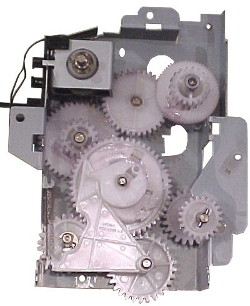
HP RM1-4532 is the main paper pickup drive assembly for the P4014, P4015 and P4515 printers.
The RM1-4532 combines two or three mechanisms. It brings together the clutch that activates the whole feedroller chain and the solenoid that releases and runs the cassette tray pickup and feed rollers (they were separate in the LJ-4200) The paper feed drive motor is sometimes called the main motor and is mounted on the back of this assembly. Clutch (RM1-5057), solenoid (RK2-0270) and motor each have their own part number. Motors should be RL1-1657 according to the manual and HP PartSurfer, however the actual number on the back of a motor is RM1-5066, so that is used by eBay vendors but not by HP parts distributors.
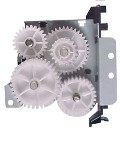 RC2-2541 and cogs
RC2-2541 and cogsRM1-4532 is just part of the paper drive cog chain. A smaller assembly with four cogs mounts above this one; the part number RC2-2541 is stamped on the metalwork and the service manual doesn't give any other. This smaller assembly provides the final drive to the feedrollers in the printers throat and what used to be called the "registration assembly" (that may be a misnomer now, as paper is straightened but doesn't stop there and HP now call it the "pre transfer roller").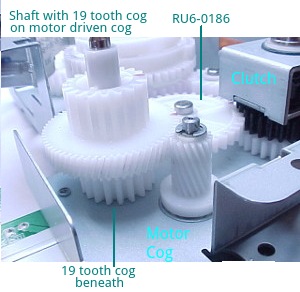
 Motor RL1-1657 - but it probably says RM1-5066 on the label
Motor RL1-1657 - but it probably says RM1-5066 on the label Motor drive gear actually two parts, neither gives a number.
Motor drive gear actually two parts, neither gives a number.The motor is an outrunner type with an external flywheel armature and integral electronics. It has a helical cog that engages the middle part of the top-forward gear in the assembly; the motor has 17 and the cog 65 teeth so there is a substantial gearing down. The motor gear is linked to to 19 tooth gears above and below it (one is a separate moulding, but that is presumably just manufacturing convenience). The upper face engages with that RC2-2541 assembly above that drives the feed rollers - so they are turning whenever the motor is.
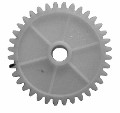 RU6-0186 cog
RU6-0186 cogThe lower face engages the remaining cog chain of the paper pickup drive. First is 36 tooth cog RU6-0186 and it turns the 29 tooth black cog on the clutch shaft.
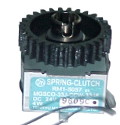 Clutch RM1-5057
Clutch RM1-5057The clutch is RM1-5057. It says it is a "Spring Clutch DC 24V 4W" Made by Tenryu Marusawa Co. Ltd MGSCO-33J-CCW-3346"and it sits over a pin on the gear. When the clutch is not powered the remaining gear chain is idle.
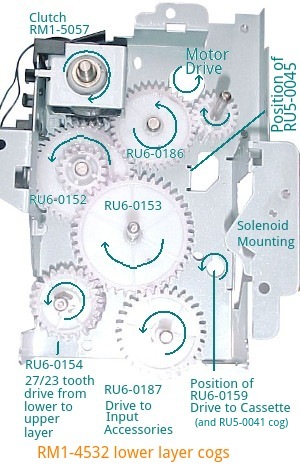
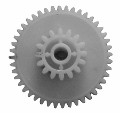 RU6-0152 reduction cog
RU6-0152 reduction cog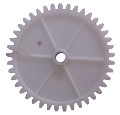 RU6-0153 big central transmission cog
RU6-0153 big central transmission cogThe clutch black gear has 29 teeth and these rotate continually when the motor runs. Immediately underneath is the white gear RU6-0157 also with 29 teeth so the clutch has no scaling effect. When the clutch engages it drives RU6-0152, a gear with 44 teeth on its lower level and 16 teeth above, again a substantial gearing down. The 16 teeth drive the big RU6-0153 41 tooth cog and this begins a chain that runs through the remainder of the printer and any input accessories. For instance the 29 tooth cog RU6-0187 in the base of the printer is visible through a slot to work the first accessory feeder.
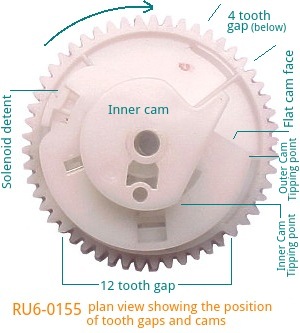
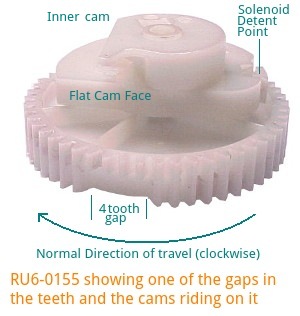
Locally RU6-0153 drives the 23 tooth level of RU6-0154, which has 27 teeth on its upper level. These would drive RU6-0155 which is mounted on the same shaft as RU6-0153 but not connected to it. RU6-0155 has positions for 53 teeth, but two gaps in them. The 4 tooth gap is normally parked next to RU6-0154 which rotates when the clutch is on but can't engage because of the gap.
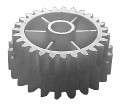
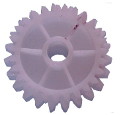 Views of RU6-0154
Views of RU6-0154
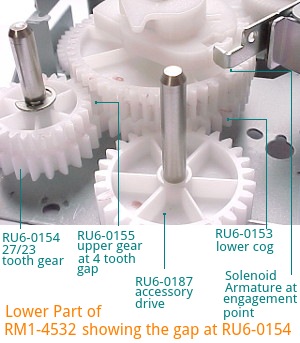
This is where the solenoid comes in. In its normal position the solenoid armature is sprung up against one of the two cams mounted on RU6-0155. The hook grips the cam at the detent point, so that the cams and gear can't rotate - and have no drive to do so because the 4-tooth gap is facing RU6-0154. Momentary action of the solenoid allows the cam to rotate beyond the detent and then RU6-0154 gets a grip, there is nothing to stop RU6-0155 until it completes one revolution, during which the pickup and feed rollers rotate and the feed roller is lowered onto the paper stack pushing a sheet off. (The relationship between gears, cams and the printer body is explored below). At the end of one revolution the gap is next to RU6-0154, the cam detent and solenoid armature engage again and the action stops. The sheet of paper has passed the first feed and separation roller in the printer's throat - feed roller set RM1-4527 driven by the cogs on RC2-2541 have taken over. The solenoid and cam act as a single-revolution clutch. The pickup, feed and separation rollers feed one piece of paper for one rotation of RU6-0155.
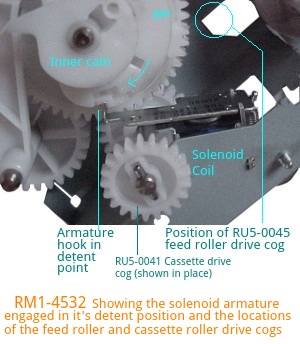
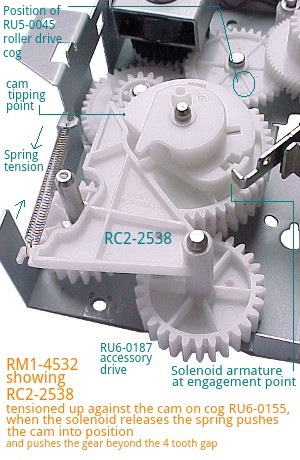
HP_RU6-0155, the big paper pickup and feed drive gear is on the same shaft as big 44 tooth gear RU6-0153 (the latter is mounted below it in the pictures). They share nothing in common except the shaft and the smaller RU6-0154 two-stage gear. RU6-0155 doesn't rotate until the solenoid operates, the teeth move beyond the gap and RU6-0154 couples them. (RU6-0155 actually rotates at a slightly different speed to RU6-0153 despite sharing a shaft and looking similar.)
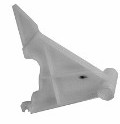 The RC2-2538 lever pushes on the cam to make sure RU6-0155 begins rotating
The RC2-2538 lever pushes on the cam to make sure RU6-0155 begins rotatingSpring loaded triangular lever RC2-2538 makes RU6-0155 positively couple to RU6-0154. At the point where the solenoid engages the cam has turned with a point resting against this lever and under some pressure from the spring. Nothing moves whilst the solenoid armature hook remains in the detent point of the cam. When the solenoid releases the cam the RC2-2538 lever pushes on the cam tipping-point and so the cog rotates by about four teeth. Now the teeth of RU6-0154 definitely engage with teeth in RU6-0155 which will complete a turn. As it completes the turn the lever has re-engaged the flattened face of the cam, but is once again firmly latched by the solenoid armature so the cog will definitely park in the zone with no teeth but be spring-loaded by RC2-2538 ready for the next turn.
The detent point of the outer RU6-0155 cam is itself very slightly spring loaded. We think it cushions the stop, reducing the shock and noise as the solenoid hook suddenly stops the action.
 The larger outer cam works the lever and has the solenoid hook's detent point
The larger outer cam works the lever and has the solenoid hook's detent point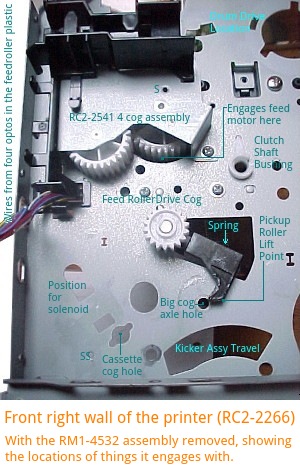
RU6-0155 carries two cams as seen in the pictures. The top one is on the inside when the mechanism is mounted on the right wall of the printer. A spike protruding through the wall from the "Z assembly" or roller lift-arm rides on the cam to lift and lower the paper pickup roller RM1-0036. This cam acts sharply because at it's tipping point it rotates freely through about 90 degrees allowing the arm to drop suddenly.
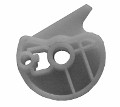 The small inner cam lowers and then lifts the pickup roller
The small inner cam lowers and then lifts the pickup rollerThe inner cam also has a prominent spike. This clearly does a different job, we just arent quite sure what it is. It rotates under the lift-arm without making contact. It seems intended to act with what used to be called the "kicker assembly". The kicker assembly appears in the LaserJet 4200 and had the part number RL1-0015-000CN and its stated purpose in HP Partsufer was Kicker assembly - Mounts to right side of the printer and is connected to the right side guide - Senses when the paper cassette is inserted into the printer
. However it isn't at all clear how it does this. This part isn't mentioned in the P4014 service manual and disappeared from the LaserJet M601 and M604 series machines so its purpose has gone.
There are a few ghosts here; the whole purpose of this mechanism is to pick up paper but there are no feed rollers in this mechanism. they are on the other side of the printer's right wall.
 RU5-0041 cog and shaft RL1-1658 have to be removed to get the unit out of the printer.
RU5-0041 cog and shaft RL1-1658 have to be removed to get the unit out of the printer.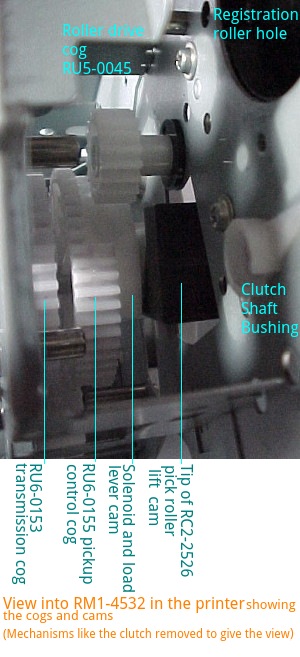
Cog RU5-0041 is inside the cassette tray space near the front right. It drives the separation roller in the cassette, via a torque limiter. This cog is on the other side of the right wall on the end of the retard drive shaft - collectively the service manual calls them RL1-1658. Whatever it is called, it has to be removed to get the RM1-4532 assembly out of the printer, which is done by taking the E-ring and spring clips off it's rear and then pulling it through from the cassette tray space. As this is done cog RU6-0159 will fall off the shaft, as will the little black bushing which doesn't seem to have a part number. In some of the pictures above we have marked the cog and shaft position - or sometimes put it back in place for demonstration purposes.
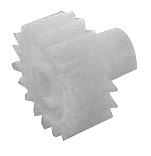 RU5-0045 cog meshes with RU6-0155 at its northeast corner
RU5-0045 cog meshes with RU6-0155 at its northeast cornerCog RU5-0045 feeds through the printer's right wall and drives the pickup and feed rollers. The cog is small, so where rotation speed was previously dropped, here it goes back up. The rollers are on a long steel shaft and a plastic moulding that suspends them midway across the paper cassette. The shaft, plastic lift plate and the cogs at the far end are mysteriously called the "Z assembly" (RM1-4562) in the service manual. The plastic moulding with the lift-spike is actually labelled RC2-2526. Only one cog is needed to drive the rollers as at the far end of the shaft for the RM1-0037 roller drives the RM1-0037 via an idle cog/planetary gear.
The tab for the pickup roller lift arm RC2-2526 protrudes through the right wall and rides on the small inner cam. This cam is on the RU6-0155 drive shaft and coupled to the cog and larger cam, however when it reaches a tipping point it can slide round about 90 degrees. This allows the pickup roller to drop suddenly onto the page.
The spring clips on the separation drive shaft are a mystery. The LJ-4200 didn't have anything like them and the neither does the LJ-M601. They seem intended to spring-load the shaft but why - there is no give in the bushings. Another ghost in the machine?
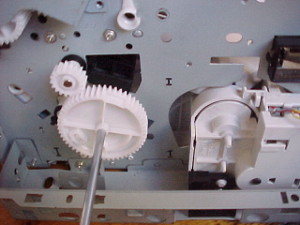 A screwdriver can serve as an axle to observe cog and cam behaviour
A screwdriver can serve as an axle to observe cog and cam behaviourOperation
It is not easy to see the RM1-4532 mechanism in action without an endoscope and a high speed camera. A rough simulation is possible. With the printer part dismantled the tray can be lifted using a 12 volt battery applied to the lift motor and stopping when the stack sensor tab has travelled up - just as the pickup roller lift spike in it's down position moves. The paper stack is where the electronics would have placed it
As an axle for the cog and cams use a screwdriver resting in the correct hole in the chassis so that the cam lifts the spike on RC2-2526 whilst the cog meshes with RU5-0045.
Turning the big cog anticlockwise will drop the pickup roller, then the cog teeth engage, paper is pushed forward, the pickup roller lifts and the feed roller carries the paper about 4 inches (100 mm) forward. In this case that is as far as things go for one turn of the big cog. If the printer were intact paper would now be in the feed rollers and go up towards the drum.
With the printer in bits turning the feed mechanism just throws pages out of the front and since the separation roller isn't driven there might be the odd double feed - but it illustrates the principles.
Similar Parts
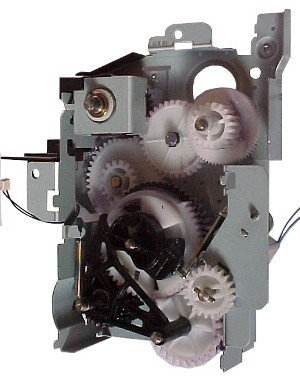
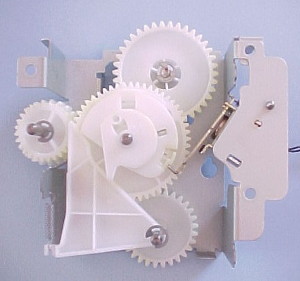
An obvious reason for this rather elaborate write-up is to penetrate the mysteries of a part of the printer not generally give much consideration. Printer cog chains incorporate several centuries of wisdom derived from clockmaking and automata. There are some oddities as well, for instance the clutch doesn't do much except start and stop the lower part of the cog-chain. Older machines had a clutch on the registration station but this does not.
The mechanism is clearly an evolution from that of the LJ-4200 RM1-0034 mechanism pictured left. That is purely the transmission gears and solenoid though.
The LJ-M601 and M604 mechanism RM1-8415 has evolved from this RM1-4532. It works in a very similar way.
Web Research
HP Partsurfer says (in July 2013):
HWP-RM1-4532-000CN Paper pick-up drive assy
RM1-4532-000CN Paper pickup drive assembly - Includes a metal plate with the paper feeder pick-up clutch, pick-up roller drive shaft, and drive gears
Icecat says RM1-4532-000CN = EAN/UPC 5704327628040 in category printer kits. There had been 40 product views suggesting a little interest.
Amazon seem to have ASIN B003D3ISM8 and B00BL5Y66M assigned by vendors
RM1-4532 fits the HP LaserJet P4014, P4015 and P4515 in all the N, TN, DN, X and XM varieties. The design or at least the part numbering changed for the M601.
A google Query for RM1-4532
in August 2013 returned About 221,000 results
.
Amazon (ZAR Systems) £53, Partshere $45, Chips £32.97 discounted to £31.54, eBay (astrocomputer) $10 (but $23.95 shipment), Misco £2,809.99 (amusingly), Morecomputers £47.90 (free delivery), Lambdatek £34.17, Printerworks (Refurb) $19.95, com-com (reformatted Partsurfer), impactcomputers $48.74 discounted to $39.95, Fastprinters $55.94, gzkds.en.alibaba no price, Sparepartswarehouse $44.03, Renewcomputer refurb $75 new $123, Ilgs refurb £18.54, printersupplies $36.48, feedroller $29.12, alibaba (Guangzhou Powershow) no price, alibaba (Guangzhou Powershow again) no price, alibaba (Guangzhou Powershow yet again) no price, Laserpros no price, Amazon (Toner and Printer) $29.12, Amazon (Quickship) $59.89, HP_Partsurfer no price, Newfuser $46.46, Marketpoint $48.85, Quikshiptoner $59.89, Pricegrabber $59.89, Printerparts-exchange $39.95. lbrty.com no price, hp-web.co.uk £38.39.
Prices noted are for a new item without tax. The list is as encountered. We haven't bothered with currency conversion - half of our readers are outside the UK and are more interested in dollar prices.
As seems usual non of the vendors listed did anything very different. Each just lists the part, the description from HP Partsurfer and a price. A few gave a picture if they are selling refurbed items. Some apparently list driven sites were all sharing a picture they seemed to have sourced from one place. Liberty Parts have some excellent photographic parts explosions.
Fitting this part may well need the service manual - and even then the diagrams are not quite good enough to reconstruct how the mechanism works. It is a job for an experience technician.
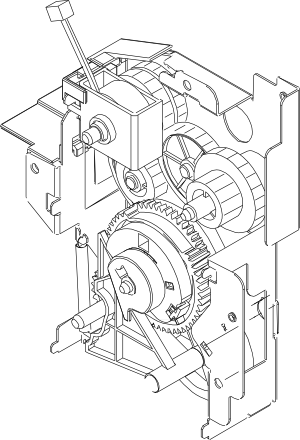
Supply Situation
Despite the amazing number of references Google finds online we can find just two UK distributors who list it and neither has local stock. Parts will probably be obtained from HP stock and we should be able supply one in 3-5 days for about £33. Alternatively we can source mechanisms "refurbished" - or more accurately clean pulls from a working printer.
We suspect that very few people will want the whole assembly. The most likely fault is the solenoid which is available separately. If it isn't the solenoid suspect the clutch. It is possible for some accident or mishandling to strip one cog and of course a dismantled printer might lose one. However the individual parts aren't available from HP.
Some clone parts may be available - which would ordinarily be a good thing. However experience of clone parts suggests that they are not made from accurate measurements but by making a mould from an original then using that to cast further parts. Since the parts used here need to be accurate that would not do. HP have also used Polyoxymethylene (POM) which we gather is a more expensive plastic than nylon 66 - so clone parts might use substitute materials.
At the time of writing (August 2013) non of the distributors was acutally listing this part althouh we think there would be little difficulty sourcing one. However whether the broker price would substantially undercut the HP price is doubtful. Even if only one cog is wanted the rest of the assembly becomes useless.
These suggestions on price and availablity are guidelines, our prices change with distribution lists - see the catalog . Stock numbers indicate there is not much call for the part.
Copyright G & J Huskinson & MindMachine Associates Ltd 2013, 2015. Some pictures derived from HP User and Service guides. These technical pages do not constitute an offer for sale; just our knowledge at the time of writing. See the catalog. Sales pages on this Web site use cookies to store user information. We also use Google Analytics to track site usage patterns.

